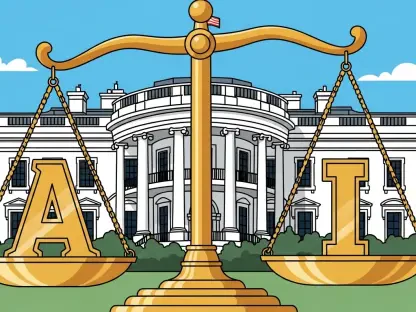The Global AI Landscape: Where America Stands
Imagine a world where artificial intelligence dictates the balance of power, shaping economies, securing nations, and redefining technological supremacy. This is no longer a distant vision but a present reality, with AI emerging as a cornerstone of global competition, placing the United States at a critical juncture as it strives to maintain leadership in an industry pivotal to national security, economic prosperity, and technological dominance. As AI permeates sectors from defense to healthcare, its strategic importance cannot be overstated, driving nations to invest heavily in innovation and infrastructure.
Currently, the United States holds a strong position in AI development, bolstered by robust private sector innovation and significant research capabilities. However, competitors like China are rapidly closing the gap with state-driven investments and expansive data resources, while the European Union focuses on stringent regulatory frameworks to balance innovation with ethical considerations. Each player brings distinct strengths to the table: America excels in cutting-edge research and entrepreneurial ecosystems, China leverages scale and government support, and the EU prioritizes trust and privacy in AI deployment. This dynamic creates a complex battlefield where dominance is far from assured.
Key AI segments such as machine learning, generative AI, and infrastructure development are shaping the industry’s trajectory. Technological influences like advanced computing power and vast data availability fuel rapid advancements, pushing boundaries in automation and decision-making. Meanwhile, international regulations and standards, including the EU’s AI Act and varying national policies, create a fragmented landscape that influences how AI is developed and deployed globally. Navigating this environment requires not only technical prowess but also strategic policy alignment to maintain a competitive edge.
Trump’s 2025 AI Action Plan: Core Components and Strategies
Key Pillars of the Plan
The comprehensive AI strategy unveiled by the Trump administration in the current year sets an ambitious roadmap through three central pillars: Accelerating Innovation, Building American AI Infrastructure, and Leading in International Diplomacy and Security. Under the innovation pillar, the focus is on deregulation to expedite market entry for AI solutions, alongside increased federal investment in research and public-private partnerships. Workforce development initiatives aim to upskill American talent, ensuring a steady pipeline of skilled professionals ready to drive advancements.
The infrastructure pillar emphasizes the expansion of physical and digital foundations critical for AI growth. This includes modernizing data centers, enhancing power grids, and securing high-quality data for training models. Security measures are integral, with policies designed to protect against foreign threats and ensure reliance on domestic or allied technologies. Such efforts aim to create a resilient backbone that supports sustained innovation while safeguarding national interests.
In the realm of international diplomacy and security, the plan seeks to position American AI as a global standard by exporting comprehensive technology stacks to allied nations. It prioritizes shaping international norms and strengthening cybersecurity to counter AI-enabled threats. Cross-cutting priorities across all pillars include protecting American workers from displacement, ensuring unbiased AI systems through guiding principles, and preventing misuse through robust safeguards, reflecting a holistic approach to leadership in this domain.
Strategic Goals and Projected Impact
The overarching ambition of this AI strategy is to cement American technological dominance while establishing global standards that reflect national values. By fostering an environment conducive to rapid innovation and infrastructure growth, the plan aims to outpace rivals and secure a leading role in defining AI’s future. This vision extends beyond mere competition, seeking to embed American influence in international frameworks and alliances that govern AI deployment.
Projected outcomes include significant economic growth through job creation in tech sectors and bolstered national security via advanced AI applications in defense. Metrics suggest a potential increase in AI-driven GDP contributions over the next few years, with estimates indicating substantial growth in high-tech employment. Additionally, strengthened cybersecurity measures are expected to mitigate risks, enhancing trust in American systems both domestically and abroad.
Looking ahead, the strategy could reposition the United States as the primary influencer in global AI discourse, provided it successfully navigates competitive pressures. Indicators of global influence, such as adoption rates of American AI technologies by allied nations, will serve as critical benchmarks. If executed effectively, this plan has the potential to redefine the competitive landscape, ensuring that American innovation remains at the forefront of technological evolution.
Challenges to American AI Dominance
Technological hurdles present a formidable barrier to maintaining leadership in AI. The pace of advancements demands constant adaptation, with emerging algorithms and computing paradigms requiring ongoing investment and expertise. Infrastructure readiness also poses a challenge, as gaps in data center capacity or power supply could hinder scalability, potentially allowing competitors to gain ground in critical areas.
Regulatory tensions further complicate the landscape, particularly the friction between federal deregulation efforts and state-level oversight. A notable example is the unsuccessful attempt to impose a moratorium on state AI regulations, highlighting a divide in governance approaches. This discord could create inconsistent environments for businesses, slowing innovation and creating uncertainty in policy implementation across regions.
Market-driven challenges add another layer of complexity, with intense competition from global rivals like China, who benefit from vast resources and coordinated strategies. Risks such as intellectual property theft and cybersecurity threats loom large, necessitating robust defenses. Potential solutions include fostering public-private partnerships to accelerate innovation and implementing enhanced security protocols to protect sensitive technologies, ensuring that American advancements remain secure and competitive.
Regulatory and Ethical Considerations in Trump’s Plan
The administration’s stance on regulation leans heavily toward promoting innovation by streamlining federal processes and reducing bureaucratic barriers. This includes reviewing past federal actions to eliminate unnecessary constraints on AI development. Such an approach aims to create a fertile ground for rapid progress, prioritizing market-driven solutions over restrictive oversight.
Ethical considerations are addressed through initiatives like executive orders establishing principles for unbiased AI, ensuring systems reflect American values and avoid ideological skew. There is a strong emphasis on trustworthiness, with guidelines designed to foster public confidence in AI applications. Federal funding allocation also ties into state regulatory environments, incentivizing innovation-friendly policies at a local level to maintain national coherence in AI policy.
Security remains a critical focus, with regulations aimed at protecting supply chains from adversarial technologies and refining risk management frameworks through established standards. These measures seek to balance the drive for innovation with the imperative to safeguard against misuse or external threats. By embedding security and ethical principles into the core of AI development, the plan strives to build a sustainable and responsible technological ecosystem.
The Future of AI Under Trump’s Vision
Emerging technologies such as open-source AI models and secure full-stack exports stand to reshape the industry under the current strategic framework. These innovations could democratize access to advanced tools while reinforcing American influence through standardized technology stacks adopted by allies. Keeping pace with such developments will be crucial to maintaining a competitive edge in an ever-evolving field.
Potential disruptors, including advancements by rival nations or unexpected misuse of AI, pose risks to sustained leadership. A breakthrough in AI capabilities by a competitor could shift global dynamics, while ethical lapses or security breaches might undermine trust. Monitoring these variables will be essential to preemptively address challenges and adapt strategies accordingly.
Global economic conditions, evolving consumer demands for ethical AI, and the strength of international alliances will also influence future growth. Economic downturns could constrain investment, while public expectations for transparency might necessitate stricter accountability measures. The plan’s adaptability to the rapid evolution of AI, through continuous policy refinement, will determine its long-term success in navigating these multifaceted influences.
Conclusion: Can Trump’s Plan Secure America’s AI Leadership?
Reflecting on the comprehensive strategy laid out by the Trump administration, it is evident that a bold vision underpins the approach to securing American leadership in artificial intelligence. The plan’s strengths, encompassing innovation acceleration, infrastructure fortification, and global influence, position it as a robust framework to tackle the complexities of the AI race. Yet, challenges like regulatory discord and international competition cast shadows over its assured success.
Looking back, critical uncertainties remain around balancing deregulation with necessary oversight and countering the rapid advancements of global rivals. These hurdles underscore the need for vigilance and flexibility in policy execution. Moving forward, stakeholders—policymakers and industry leaders alike—should prioritize fostering cohesive national regulations and strengthening cybersecurity defenses to protect intellectual assets.
As a next step, establishing stronger public-private collaborations could amplify innovation while addressing ethical concerns through transparent guidelines. International partnerships should be deepened to cement American standards globally, ensuring that technological leadership translates into enduring influence. By focusing on these actionable measures, the foundation laid by the plan can be built upon to navigate the dynamic AI landscape effectively.









